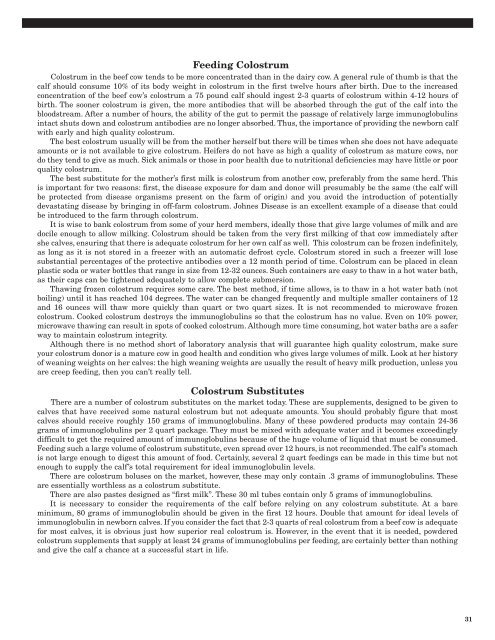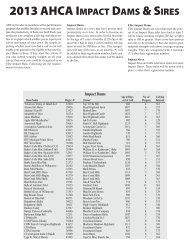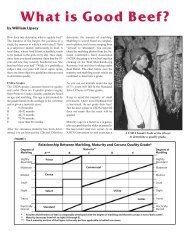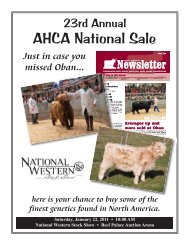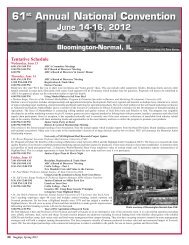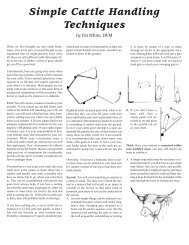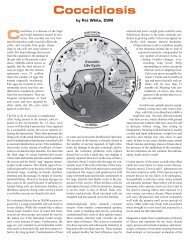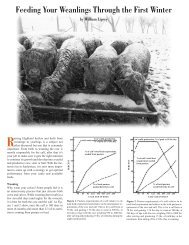The Bagpipe - American Highland Cattle Association
The Bagpipe - American Highland Cattle Association
The Bagpipe - American Highland Cattle Association
Create successful ePaper yourself
Turn your PDF publications into a flip-book with our unique Google optimized e-Paper software.
Feeding Colostrum<br />
Colostrum in the beef cow tends to be more concentrated than in the dairy cow. A general rule of thumb is that the<br />
calf should consume 10% of its body weight in colostrum in the first twelve hours after birth. Due to the increased<br />
concentration of the beef cow’s colostrum a 75 pound calf should ingest 2-3 quarts of colostrum within 4-12 hours of<br />
birth. <strong>The</strong> sooner colostrum is given, the more antibodies that will be absorbed through the gut of the calf into the<br />
bloodstream. After a number of hours, the ability of the gut to permit the passage of relatively large immunoglobulins<br />
intact shuts down and colostrum antibodies are no longer absorbed. Thus, the importance of providing the newborn calf<br />
with early and high quality colostrum.<br />
<strong>The</strong> best colostrum usually will be from the mother herself but there will be times when she does not have adequate<br />
amounts or is not available to give colostrum. Heifers do not have as high a quality of colostrum as mature cows, nor<br />
do they tend to give as much. Sick animals or those in poor health due to nutritional deficiencies may have little or poor<br />
quality colostrum.<br />
<strong>The</strong> best substitute for the mother’s first milk is colostrum from another cow, preferably from the same herd. This<br />
is important for two reasons: first, the disease exposure for dam and donor will presumably be the same (the calf will<br />
be protected from disease organisms present on the farm of origin) and you avoid the introduction of potentially<br />
devastating disease by bringing in off-farm colostrum. Johnes Disease is an excellent example of a disease that could<br />
be introduced to the farm through colostrum.<br />
It is wise to bank colostrum from some of your herd members, ideally those that give large volumes of milk and are<br />
docile enough to allow milking. Colostrum should be taken from the very first milking of that cow immediately after<br />
she calves, ensuring that there is adequate colostrum for her own calf as well. This colostrum can be frozen indefinitely,<br />
as long as it is not stored in a freezer with an automatic defrost cycle. Colostrum stored in such a freezer will lose<br />
substantial percentages of the protective antibodies over a 12 month period of time. Colostrum can be placed in clean<br />
plastic soda or water bottles that range in size from 12-32 ounces. Such containers are easy to thaw in a hot water bath,<br />
as their caps can be tightened adequately to allow complete submersion.<br />
Thawing frozen colostrum requires some care. <strong>The</strong> best method, if time allows, is to thaw in a hot water bath (not<br />
boiling) until it has reached 104 degrees. <strong>The</strong> water can be changed frequently and multiple smaller containers of 12<br />
and 16 ounces will thaw more quickly than quart or two quart sizes. It is not recommended to microwave frozen<br />
colostrum. Cooked colostrum destroys the immunoglobulins so that the colostrum has no value. Even on 10% power,<br />
microwave thawing can result in spots of cooked colostrum. Although more time consuming, hot water baths are a safer<br />
way to maintain colostrum integrity.<br />
Although there is no method short of laboratory analysis that will guarantee high quality colostrum, make sure<br />
your colostrum donor is a mature cow in good health and condition who gives large volumes of milk. Look at her history<br />
of weaning weights on her calves: the high weaning weights are usually the result of heavy milk production, unless you<br />
are creep feeding, then you can’t really tell.<br />
Colostrum Substitutes<br />
<strong>The</strong>re are a number of colostrum substitutes on the market today. <strong>The</strong>se are supplements, designed to be given to<br />
calves that have received some natural colostrum but not adequate amounts. You should probably figure that most<br />
calves should receive roughly 150 grams of immunoglobulins. Many of these powdered products may contain 24-36<br />
grams of immunoglobulins per 2 quart package. <strong>The</strong>y must be mixed with adequate water and it becomes exceedingly<br />
difficult to get the required amount of immunoglobulins because of the huge volume of liquid that must be consumed.<br />
Feeding such a large volume of colostrum substitute, even spread over 12 hours, is not recommended. <strong>The</strong> calf’s stomach<br />
is not large enough to digest this amount of food. Certainly, several 2 quart feedings can be made in this time but not<br />
enough to supply the calf’s total requirement for ideal immunoglobulin levels.<br />
<strong>The</strong>re are colostrum boluses on the market, however, these may only contain .3 grams of immunoglobulins. <strong>The</strong>se<br />
are essentially worthless as a colostrum substitute.<br />
<strong>The</strong>re are also pastes designed as “first milk”. <strong>The</strong>se 30 ml tubes contain only 5 grams of immunoglobulins.<br />
It is necessary to consider the requirements of the calf before relying on any colostrum substitute. At a bare<br />
minimum, 80 grams of immunoglobulin should be given in the first 12 hours. Double that amount for ideal levels of<br />
immunoglobulin in newborn calves. If you consider the fact that 2-3 quarts of real colostrum from a beef cow is adequate<br />
for most calves, it is obvious just how superior real colostrum is. However, in the event that it is needed, powdered<br />
colostrum supplements that supply at least 24 grams of immunoglobulins per feeding, are certainly better than nothing<br />
and give the calf a chance at a successful start in life.<br />
31


